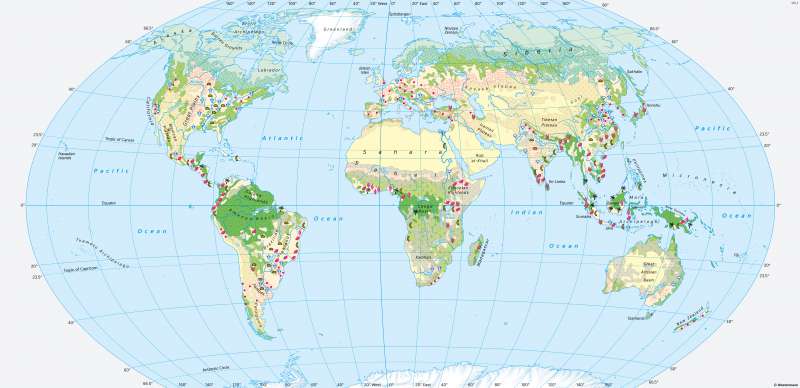The World - Landscapes and land use
Landscapes and land use
978-3-14-100890-6 | Page 24 | Ill. 1

Overview
The map shows the distribution of the vegetation zones of the Earth. A total of 13 different types of land cover are distinguished. which are divided into three main categories: forest landscapes, open landscapes, and cultivated land.
Dependence of vegetation zones on climate
The map clearly shows the zonal arrangement of the Earth's vegetation zones - despite the widespread influence of humans. The vegetation zones are primarily based on the Earth's climate zones. They have different annual average values of temperature and precipitation. In the monsoon and rain forests along the equator, for example, the year-round high precipitation and temperatures give rise to evergreen rain forests with a very large diversity of species. The duration of the dry season is limited to a maximum of two months. Monsoon forests are open woodlands in tropical areas that have a long dry season followed by a season of heavy rainfall.
While the moist savanna adjoining to the north and south is still dominated by vegetation with numerous trees, their number gradually decreases with increasing distance from the equator due to the lower humidity. There is a transition to dry savanna and finally to thornbush savanna. In the savannas, the vegetation has adapted to the recurring lack of water through appropriate growth forms.
The deserts and semi-deserts in Africa, Asia and Australia, on the other hand, have almost no vegetation. There, precipitation is so low that, if at all, only very sparse vegetation remains.
In the summer-dry areas (Mediterranean region), hard-leaved evergreen vegetation is a special form of adaptation. Small, thick leaves that are partly covered with wax-coated leaves, for example, protect these plants.
The Mid-Latitudes of the Northern Hemisphere - which includes Germany - is dominated by
cultivated land as well as deciduous and mixed forests. In the zone of the northern coniferous forest (in Siberia: taiga) and the tundra, temperature conditions have a decisive effect on plant growth. Due to the short summer vegetation period (three to five months), which would not be enough time for the leaves of deciduous trees to grow, coniferous tree species predominate in this area.
The zone of polar deserts, in which plant growth is no longer possible, includes large parts of the Arctic and the Antarctic. The freezing point is rarely exceeded, and precipitation is low.
Distribution of crops
The vegetation zones have very different arable potential. For this reason, typical forms of agriculture and crops can be assigned to them. For example, the temperature and precipitation conditions around the equator allow the cultivation of particularly heat- and moisture-loving crops such as bananas, pineapples, cocoa, and coffee. The poleward decrease in precipitation is accompanied by a change in crops towards more drought-resistant plant species. In savanna areas, for example, maize, millet, peanuts, and cassava are cultivated, along with livestock as drought increases. In desert regions, agriculture is essentially limited to cultivation in oases and livestock farming. In oases, date palms (fruit, timber, and firewood) are of particular importance.
The zone of temperate hard-leaved vegetation is mainly used for the cultivation of cereals, citrus fruits (orange, lemons), wine, olives, and vegetables. In the steppe area, wheat, maize, sunflowers and - if temperatures permit - cotton are common. In the high mountain grasslands, pasture dominates. In the Mid-Latitudes of deciduous and mixed forests, there is sufficient heat and moisture to grow a variety of fruits and vegetables in addition to cereals. The climatic conditions of the coniferous forest zone already considerably restrict the cultivation of crops and only partially allow the cultivation of rye and potatoes. In addition, the forestry is of great importance. In the area of treeless tundra, only extensive reindeer herding is possible.




